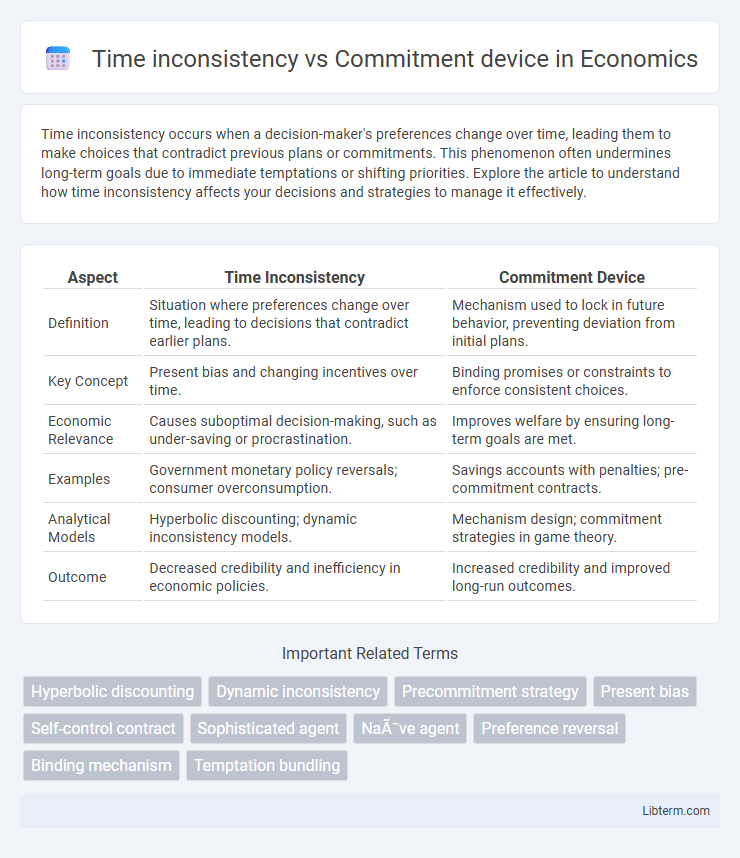Time inconsistency occurs when a decision-maker's preferences change over time, leading them to make choices that contradict previous plans or commitments. This phenomenon often undermines long-term goals due to immediate temptations or shifting priorities. Explore the article to understand how time inconsistency affects your decisions and strategies to manage it effectively.
Table of Comparison
| Aspect | Time Inconsistency | Commitment Device |
|---|---|---|
| Definition | Situation where preferences change over time, leading to decisions that contradict earlier plans. | Mechanism used to lock in future behavior, preventing deviation from initial plans. |
| Key Concept | Present bias and changing incentives over time. | Binding promises or constraints to enforce consistent choices. |
| Economic Relevance | Causes suboptimal decision-making, such as under-saving or procrastination. | Improves welfare by ensuring long-term goals are met. |
| Examples | Government monetary policy reversals; consumer overconsumption. | Savings accounts with penalties; pre-commitment contracts. |
| Analytical Models | Hyperbolic discounting; dynamic inconsistency models. | Mechanism design; commitment strategies in game theory. |
| Outcome | Decreased credibility and inefficiency in economic policies. | Increased credibility and improved long-run outcomes. |
Understanding Time Inconsistency: Definition and Examples
Time inconsistency occurs when individuals' preferences change over time, leading them to make decisions that their future selves would regret. This behavioral phenomenon is illustrated by procrastination in saving for retirement or choosing immediate gratification over long-term benefits. Commitment devices help mitigate time inconsistency by locking individuals into actions that align with their long-term goals, thereby reducing the temptation of impulsive decisions.
The Psychology Behind Time-Inconsistent Behavior
Time-inconsistent behavior arises when individuals prioritize immediate rewards over long-term benefits due to present-biased preferences and impulsivity, often explained by hyperbolic discounting in behavioral economics. Commitment devices function as psychological tools or mechanisms that help individuals overcome their self-control challenges by restricting future choices or increasing the cost of deviating from long-term goals. Understanding the cognitive conflict between short-term desires and long-term intentions is crucial for designing effective commitment strategies that align behavior with future welfare.
Commitment Devices: What Are They?
Commitment devices are strategies or tools designed to help individuals stick to long-term goals by restricting future choices that may lead to time-inconsistent behavior. They work by creating consequences or barriers that align immediate actions with future intentions, effectively countering impulsive decisions driven by present bias. Examples include automatic savings plans, pre-commitment contracts, and deadlines that enforce discipline and enhance self-control.
How Commitment Devices Address Time Inconsistency
Commitment devices counteract time inconsistency by aligning immediate actions with long-term goals through precommitment strategies, reducing the temptation to deviate in the moment. These mechanisms, such as automatic savings plans or binding contracts, create external constraints that limit impulsive behavior and promote consistent decision-making over time. By structuring choices upfront, commitment devices enhance self-control and ensure adherence to planned objectives despite shifting preferences or short-term biases.
Real-World Examples of Commitment Devices
Time inconsistency arises when individuals' preferences change over time, leading to decisions that contradict earlier plans. Commitment devices, such as automatic savings plans or gym membership contracts, help align long-term goals with short-term behavior by restricting future choices. Real-world examples include tobacco quitlines that require upfront payment for multiple sessions and apps that block distracting websites during work hours, effectively reducing impulsive lapses.
Comparing Time Inconsistency and Commitment Mechanisms
Time inconsistency occurs when an individual's preferences change over time, leading to decisions that contradict earlier plans, often resulting in procrastination or failure to follow through. Commitment devices serve as mechanisms designed to lock in future behavior, helping individuals adhere to their long-term goals despite shifting preferences. Comparing time inconsistency and commitment mechanisms highlights how commitment tools effectively mitigate the negative effects of time-inconsistent preferences by aligning short-term actions with long-term intentions.
Behavioral Economics: Insights on Self-Control and Commitment
Time inconsistency occurs when individuals' preferences change over time, leading to choices that contradict earlier plans, often driven by immediate gratification. Commitment devices act as tools or strategies that help individuals align their short-term actions with long-term goals by restricting future choices or increasing the cost of temptations. Behavioral economics highlights how these devices improve self-control, reducing impulsive behavior and enhancing goal adherence through mechanisms like pre-commitment and self-imposed penalties.
Benefits and Limitations of Commitment Devices
Commitment devices help individuals overcome time inconsistency by restricting future choices to align actions with long-term goals, enhancing self-control and reducing procrastination. These tools, such as automatic savings plans or pre-committed workout schedules, provide structure that mitigates impulsive decisions that favor immediate gratification. However, limitations include reduced flexibility to adapt to unforeseen circumstances and the risk of commitment failure if motivation wanes or external factors change.
Strategies to Overcome Time Inconsistency
Time inconsistency occurs when individuals' preferences change over time, leading to decisions that contradict their earlier plans. Commitment devices, such as automatic savings plans or binding contracts, effectively align present actions with long-term goals by restricting future choices. Strategies to overcome time inconsistency include setting clear deadlines, exploiting precommitment mechanisms, and using self-imposed penalties to maintain consistent behavior over time.
Practical Tips for Implementing Commitment Devices
Implementing commitment devices effectively requires setting clear, measurable goals and using external enforcement mechanisms such as financial penalties or social accountability to counteract time inconsistency in decision-making. Practical tips include automating savings plans, leveraging apps that restrict access to distractions, and enlisting friends or mentors to monitor progress. Consistently reviewing and adjusting these devices enhances their reliability and helps align short-term actions with long-term intentions.
Time inconsistency Infographic

 libterm.com
libterm.com